Chapter 7. Functions: C++’s Programming Modules
In this chapter you’ll learn about the following:
• Function basics
• Function prototypes
• How to pass function arguments by value
• How to design functions to process arrays
• How to use const pointer parameters
• How to design functions to process text strings
• How to design functions to process structures
• How to design functions to objects of the string class
• Functions that call themselves (recursion)
• Pointers to functions
Fun is where you find it. Look closely, and you can find it in functions. C++ comes with a large library of useful functions (the standard ANSI C library plus several C++ classes), but real programming pleasure comes with writing your own functions. This chapter and Chapter 8, “Adventures in Functions,” examine how to define functions, convey information to them, and retrieve information from them. After reviewing how functions work, this chapter concentrates on how to use functions in conjunction with arrays, strings, and structures. Finally, it touches on recursion and pointers to functions. If you’ve paid your C dues, you’ll find much of this chapter familiar. But don’t be lulled into a false sense of expertise. C++ has made several additions to what C functions can do, and Chapter 8 deals primarily with those. Meanwhile, let’s attend to the fundamentals.
Function Review
Let’s review what you’ve already seen about functions. To use a C++ function, you must do the following:
• Provide a function definition.
• Provide a function prototype.
• Call the function.
If you’re using a library function, the function has already been defined and compiled for you. Also, you can use a standard library header file to provide the prototype. All that’s left to do is call the function properly. The examples so far in this book have done that several times. For example, the standard C library includes the strlen() function for finding the length of the string. The associated standard header file cstring contains the function prototype for strlen() and several other string-related functions. This advance work allows you to use the strlen() function in programs without further worries.
But when you create your own functions, you have to handle all three aspects—defining, prototyping, and calling—yourself. Listing 7.1 shows these steps in a short example.
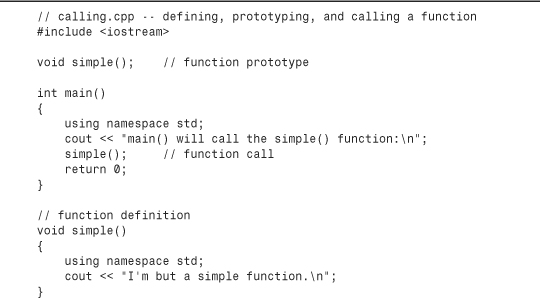
Here’s the output of the program in Listing 7.1:
main() will call the simple() function:
I'm but a simple function.
This example places a using directive inside each function definition because each function uses cout. Alternatively, the program could place a single using directive above the function definitions.
Let’s take a more detailed look at these steps now.
Defining a Function
You can group functions into two categories: those that don’t have return values and those that do. Functions without return values are termed type void functions and have the following general form:
void functionName(parameterList)
{
statement(s)
return; // optional
}
Here parameterList specifies the types and number of arguments (parameters) passed to the function. This chapter more fully investigates this list later. The optional return statement marks the end of the function. Otherwise, the function terminates at the closing brace. Type void functions correspond to Pascal procedures, FORTRAN subroutines, and modern BASIC subprogram procedures. Typically, you use a void function to perform some sort of action. For example, a function to print Cheers! a given number (n) of times could look like this:
void cheers(int n) // no return value
{
using namespace std;
for (int i = 0; i < n; i++)
cout << "Cheers! ";
cout << endl;
}
The int n parameter list means that cheers() expects to have an int value passed to it as an argument when you call this function.
A function with a return value produces a value that it returns to the function that called it. In other words, if the function returns the square root of 9.0 (sqrt(9.0)), the function call has the value 3.0. Such a function is declared as having the same type as the value it returns. Here is the general form:
typeName functionName(parameterList)
{
statements
return value; // value is type cast to type typeName
}
Functions with return values require that you use a return statement so that the value is returned to the calling function. The value itself can be a constant, a variable, or a more general expression. The only requirement is that the expression reduce to a value that has, or is convertible to, the typeName type. (If the declared return type is, say, double, and the function returns an int expression, the int value is type cast to type double.) The function then returns the final value to the function that called it. C++ does place a restriction on what types you can use for a return value: The return value cannot be an array. Everything else is possible—integers, floating-point numbers, pointers, and even structures and objects! (Interestingly, even though a C++ function can’t return an array directly, it can return an array that’s part of a structure or object.)
As a programmer, you don’t need to know how a function returns a value, but knowing the method might clarify the concept for you. (Also, it gives you something to talk about with your friends and family.) Typically, a function returns a value by copying the return value to a specified CPU register or memory location. Then, the calling program examines that location. Both the returning function and the calling function have to agree on the type of data at that location. The function prototype tells the calling program what to expect, and the function definition tells the called program what to return (see Figure 7.1). Providing the same information in the prototype as in the definition might seem like extra work, but it makes good sense. Certainly, if you want a courier to pick up something from your desk at the office, you enhance the odds of the task being done right if you provide a description of what you want both to the courier and to someone at the office.
Figure 7.1. A typical return value mechanism.

A function terminates after executing a return statement. If a function has more than one return statement—for example, as alternatives to different if else selections—the function terminates after it executes the first return statement it reaches. For example, in the following example, the else isn’t needed, but it does help the casual reader understand the intent:
int bigger(int a, int b)
{
if (a > b )
return a; // if a > b, function terminates here
else
return b; // otherwise, function terminates here
}
Functions with return values are much like functions in Pascal, FORTRAN, and BASIC. They return a value to the calling program, which can then assign that value to a variable, display the value, or otherwise use it. Here’s a simple example that returns the cube of a type double value:
double cube(double x) // x times x times x
{
return x * x * x; // a type double value
}
For example, the function call cube(1.2) returns the value 1.728. Note that this return statement uses an expression. The function computes the value of the expression (1.728, in this case) and returns the value.
Prototyping and Calling a Function
By now you are familiar with making function calls, but you may be less comfortable with function prototyping because that’s often been hidden in the include files. Listing 7.2 shows the cheers() and cube() functions used in a program; notice the function prototypes.
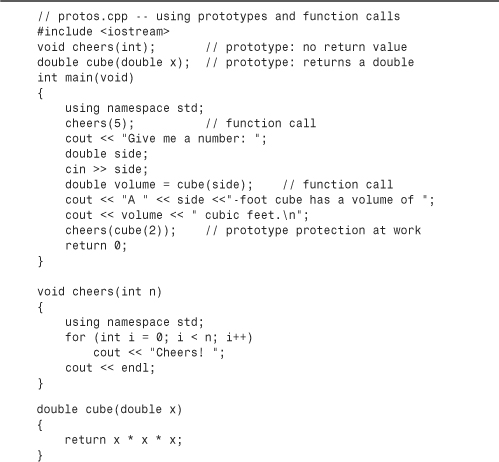
The program in Listing 7.2 places a using directive in only those functions that use the members of the std namespace. Here’s a sample run:
Cheers! Cheers! Cheers! Cheers! Cheers!
Give me a number: 5
A 5-foot cube has a volume of 125 cubic feet.
Cheers! Cheers! Cheers! Cheers! Cheers! Cheers! Cheers! Cheers!
Note that main() calls the type void function cheers() by using the function name and arguments followed by a semicolon: cheers(5);. This is an example of a function call statement. But because cube() has a return value, main() can use it as part of an assignment statement:
double volume = cube(side);
But I said earlier that you should concentrate on the prototypes. What should you know about prototypes? First, you should understand why C++ requires prototypes. Then, because C++ requires prototypes, you should know the proper syntax. Finally, you should appreciate what the prototype does for you. Let’s look at these points in turn, using Listing 7.2 as a basis for discussion.
Why Prototypes?
A prototype describes the function interface to the compiler. That is, it tells the compiler what type of return value, if any, the function has, and it tells the compiler the number and type of function arguments. Consider, for example, how a prototype affects this function call from Listing 7.2:
double volume = cube(side);
First, the prototype tells the compiler that cube() should have one type double argument. If the program fails to provide the argument, prototyping allows the compiler to catch the error. Second, when the cube() function finishes its calculation, it places its return value at some specified location—perhaps in a CPU register, perhaps in memory. Then, the calling function, main() in this case, retrieves the value from that location. Because the prototype states that cube() is type double, the compiler knows how many bytes to retrieve and how to interpret them. Without that information, the compiler could only guess, and that is something compilers won’t do.
Still, you might wonder, why does the compiler need a prototype? Can’t it just look further in the file and see how the functions are defined? One problem with that approach is that it is not very efficient. The compiler would have to put compiling main() on hold while searching the rest of the file. An even more serious problem is the fact that the function might not even be in the file. C++ allows you to spread a program over several files, which you can compile independently and then combine later. In such a case, the compiler might not have access to the function code when it’s compiling main(). The same is true if the function is part of a library. The only way to avoid using a function prototype is to place the function definition before its first use. That is not always possible. Also, the C++ programming style is to put main() first because it generally provides the structure for the whole program.
Prototype Syntax
A function prototype is a statement, so it must have a terminating semicolon. The simplest way to get a prototype is to copy the function header from the function definition and add a semicolon. That’s what the program in Listing 7.2 does for cube():
double cube(double x); // add ; to header to get prototype
However, the function prototype does not require that you provide names for the variables; a list of types is enough. The program in Listing 7.2 prototypes cheers() by using only the argument type:
void cheers(int); // okay to drop variable names in prototype
In general, you can either include or exclude variable names in the argument lists for prototypes. The variable names in the prototype just act as placeholders, so if you do use names, they don’t have to match the names in the function definition.
What Prototypes Do for You
You’ve seen that prototypes help the compiler. But what do they do for you? They greatly reduce the chances of program errors. In particular, prototypes ensure the following:
• The compiler correctly handles the function return value.
• The compiler checks that you use the correct number of function arguments.
• The compiler checks that you use the correct type of arguments. If you don’t, it converts the arguments to the correct type, if possible.
We’ve already discussed how to correctly handle the return value. Let’s look now at what happens when you use the wrong number of arguments. For example, suppose you make the following call:
double z = cube();
Without function prototyping, the compiler lets this go by. When the function is called, it looks where the call to cube() should have placed a number and uses whatever value happens to be there. This is how C worked before ANSI C borrowed prototyping from C++. Because prototyping is optional for ANSI C, this is how some C programs still work. But in C++ prototyping is not optional, so you are guaranteed protection from that sort of error.
Next, suppose you provide an argument but it is the wrong type. In C, this could create weird errors. For example, if a function expects a type int value (assume that’s 16 bits) and you pass a double (assume that’s 64 bits), the function looks at just the first 16 bits of the 64 and tries to interpret them as an int value. However, C++ automatically converts the value you pass to the type specified in the prototype, provided that both are arithmetic types. For example, Listing 7.2 manages to get two type mismatches in one statement:
cheers(cube(2));
First, the program passes the int value of 2 to cube(), which expects type double. The compiler, noting that the cube() prototype specifies a type double argument, converts 2 to 2.0, a type double value. Then, cube() returns a type double value (8.0) to be used as an argument to cheers(). Again, the compiler checks the prototypes and notes that cheers() requires an int. It converts the return value to the integer 8. In general, prototyping produces automatic type casts to the expected types. (Function overloading, discussed in Chapter 8, can create ambiguous situations, however, that prevent some automatic type casts.)
Automatic type conversion doesn’t head off all possible errors. For example, if you pass a value of 8.33E27 to a function that expects an int, such a large value cannot be converted correctly to a mere int. Some compilers warn you of possible data loss when there is an automatic conversion from a larger type to a smaller.
Also, prototyping results in type conversion only when it makes sense. It won’t, for example, convert an integer to a structure or pointer.
Prototyping takes place during compile time and is termed static type checking. Static type checking, as you’ve just seen, catches many errors that are much more difficult to catch during runtime.
Function Arguments and Passing by Value
It’s time to take a closer look at function arguments. C++ normally passes arguments by value. That means the numeric value of the argument is passed to the function, where it is assigned to a new variable. For example, Listing 7.2 has this function call:
double volume = cube(side);
Here side is a variable that, in the sample run, had the value 5. The function header for cube(), recall, was this:
double cube(double x)
When this function is called, it creates a new type double variable called x and assigns the value 5 to it. This insulates data in main() from actions that take place in cube() because cube() works with a copy of side rather than with the original data. You’ll see an example of this protection soon. A variable that’s used to receive passed values is called a formal argument or formal parameter. The value passed to the function is called the actual argument or actual parameter. To simplify matters a bit, the C++ Standard uses the word argument by itself to denote an actual argument or parameter and the word parameter by itself to denote a formal argument or parameter. Using this terminology, argument passing assigns the argument to the parameter. (See Figure 7.2.)
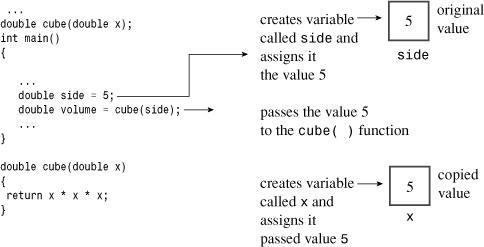
Variables, including parameters, declared within a function are private to the function. When a function is called, the computer allocates the memory needed for these variables. When the function terminates, the computer frees the memory that was used for those variables. (Some C++ literature refers to this allocating and freeing of memory as creating and destroying variables. That does make it sound much more exciting.) Such variables are called local variables because they are localized to the function. As mentioned previously, this helps preserve data integrity. It also means that if you declare a variable called x in main() and another variable called x in some other function, these are two distinct, unrelated variables, much as the Albany in California is distinct from the Albany in New York. (See Figure 7.3.) Such variables are also termed automatic variables because they are allocated and deallocated automatically during program execution.

Multiple Arguments
A function can have more than one argument. In the function call, you just separate the arguments with commas:
n_chars('R', 25);
This passes two arguments to the function n_chars(), which will be defined shortly.
Similarly, when you define the function, you use a comma-separated list of parameter declarations in the function header:
void n_chars(char c, int n) // two arguments
This function header states that the function n_chars() takes one type char argument and one type int argument. The parameters c and n are assigned the values passed to the function. If a function has two parameters of the same type, you have to give the type of each parameter separately. You can’t combine declarations the way you can when you declare regular variables:
void fifi(float a, float b) // declare each variable separately
void fufu(float a, b) // NOT acceptable
As with other functions, you just add a semicolon to get a prototype:
void n_chars(char c, int n); // prototype, style 1
As with single arguments, you don’t have to use the same variable names in the prototype as in the definition, and you can omit the variable names in the prototype:
void n_chars(char, int); // prototype, style 2
However, providing variable names can make the prototype more understandable, particularly if two parameters are the same type. Then, the names can remind you which argument is which:
double melon_density(double weight, double volume);
Listing 7.3 shows an example of a function with two arguments. It also illustrates how changing the value of a formal parameter in a function has no effect on the data in the calling program.
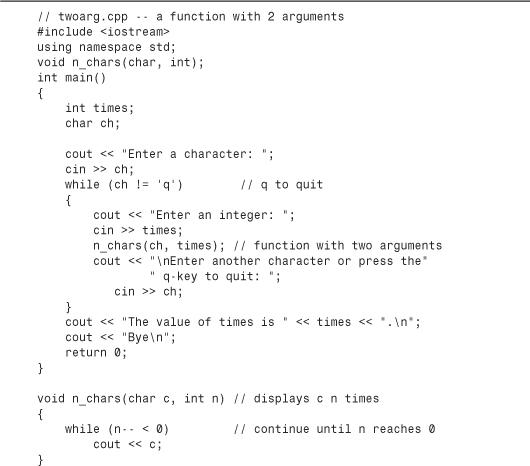
The program in Listing 7.3 illustrates placing a using directive above the function definitions rather than within the functions. Here is a sample run:
Enter a character: W
Enter an integer: 50
WWWWWWWWWWWWWWWWW
WWWWWWWWWWWWWWWWWWWWWWWWWWWWWWWWW
Enter another character or press the q-key to quit: a
Enter an integer: 20
aaaaaaaaaaaaaaaaaaaa
Enter another character or press the q-key to quit: q
The value of times is 20.
Bye
Program Notes
The main() function in Listing 7.3 uses a while loop to provide repeated input (and to keep your loop skills fresh). Note that it uses cin >> ch rather than cin.get(ch) or ch = cin.get() to read a character. There’s a good reason for this. Recall that the two cin.get() functions read all input characters, including spaces and newlines, whereas cin >> skips spaces and newlines. When you respond to the program prompt, you have to press Enter at the end of each line, thus generating a newline character. The cin >> ch approach conveniently skips over these newlines, but the cin.get() siblings read the newline following each number entered as the next character to display. You can program around this nuisance, but it’s simpler to use cin as the program in Listing 7.3 does.
The n_chars() function takes two arguments: a character c and an integer n. It then uses a loop to display the character the number of times the integer specifies:
while (n-- > 0) // continue until n reaches 0
cout << c;
Notice that the program keeps count by decrementing the n variable, where n is the formal parameter from the argument list. This variable is assigned the value of the times variable in main(). The while loop then decreases n to 0, but, as the sample run demonstrates, changing the value of n has no effect on times.
Another Two-Argument Function
Let’s create a more ambitious function—one that performs a nontrivial calculation. Also, the function will illustrate the use of local variables other than the function’s formal arguments.
Many states in the United States now sponsor a lottery with some form of Lotto game. Lotto lets you pick a certain number of choices from a card. For example, you might get to pick 6 numbers from a card having 51 numbers. Then, the Lotto managers pick 6 numbers at random. If your choice exactly matches theirs, you win a few million dollars or so. Our function will calculate the probability that you have a winning pick. (Yes, a function that successfully predicts the winning picks themselves would be more useful, but C++, although powerful, has yet to implement psychic faculties.)
First, you need a formula. If you have to pick 6 values out of 51, mathematics says that you have 1 chance in R of winning, where the following formula gives R:
![]()
For 6 choices, the denominator is the product of the first 6 integers, or 6 factorial. The numerator is also the product of 6 consecutive numbers, this time starting with 51 and going down. More generally, if you pick picks values out of numbers numbers, the denominator is picks factorial and the numerator is the product of picks integers, starting with the value numbers and working down. You can use a for loop to make that calculation:
long double result = 1.0;
for (n = numbers, p = picks; p > 0; n--, p--)
result = result * n / p ;
Rather than multiply all the numerator terms first, the loop begins by multiplying 1.0 by the first numerator term and then dividing by the first denominator term. Then, in the next cycle, the loop multiplies and divides by the second numerator and denominator terms. This keeps the running product smaller than if you did all the multiplication first. For example, compare
(10 * 9) / (2 * 1)
with
(10 / 2) * (9 / 1)
The first evaluates to 90 / 2 and then to 45, whereas the second evaluates to 5 × 9 and then to 45. Both give the same answer, but the first method produces a larger intermediate value (90) than does the second. The more factors you have, the bigger the difference gets. For large numbers, this strategy of alternating multiplication with division can keep the calculation from overflowing the maximum possible floating-point value.
Listing 7.4 incorporates this formula into a probability() function. Because the number of picks and the total number of choices should be positive values, the program uses the unsigned int type (unsigned, for short) for those quantities. Multiplying several integers can produce pretty large results, so lotto.cpp uses the long double type for the function’s return value. Also, terms such as 49 / 6 produce a truncation error for integer types.
Compatibility Note
![]()
Some C++ implementations don’t support type long double. If your implementation falls into that category, try ordinary double instead.

Here’s a sample run of the program in Listing 7.4:
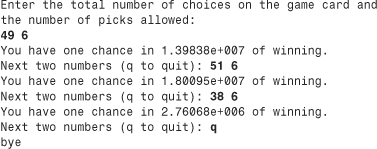
Notice that increasing the number of choices on the game card greatly increases the odds against winning.
Program Notes
The probability() function in Listing 7.4 illustrates two kinds of local variables you can have in a function. First, there are the formal parameters (numbers and picks), which are declared in the function header before the opening brace. Then come the other local variables (result, n, and p). They are declared in between the braces bounding the function definition. The main difference between the formal parameters and the other local variables is that the formal parameters get their values from the function that calls probability(), whereas the other variables get values from within the function.
Functions and Arrays
So far the sample functions in this book have been simple, using only the basic types for arguments and return values. But functions can be the key to handling more involved types, such as arrays and structures. Let’s take a look now at how arrays and functions get along with each other.
Suppose you use an array to keep track of how many cookies each person has eaten at a family picnic. (Each array index corresponds to a person, and the value of the element corresponds to the number of cookies that person has eaten.) Now you want the total. That’s easy to find; you just use a loop to add all the array elements. But adding array elements is such a common task that it makes sense to design a function to do the job. Then, you won’t have to write a new loop every time you have to sum an array.
Let’s consider what the function interface involves. Because the function calculates a sum, it should return the answer. If you keep your cookies intact, you can use a function with a type int return value. So that the function knows what array to sum, you want to pass the array name as an argument. And to make the function general so that it is not restricted to an array of a particular size, you pass the size of the array. The only new ingredient here is that you have to declare that one of the formal arguments is an array name. Let’s see what that and the rest of the function header look like:
int sum_arr(int arr[], int n) // arr = array name, n = size
This looks plausible. The brackets seem to indicate that arr is an array, and the fact that the brackets are empty seems to indicate that you can use the function with an array of any size. But things are not always as they seem: arr is not really an array; it’s a pointer! The good news is that you can write the rest of the function just as if arr were an array. First, let’s ensure that this approach works, and then let’s look into why it works.
Listing 7.5 illustrates using a pointer as if it were an array name. The program initializes the array to some values and uses the sum_arr() function to calculate the sum. Note that the sum_arr() function uses arr as if it were an array name.
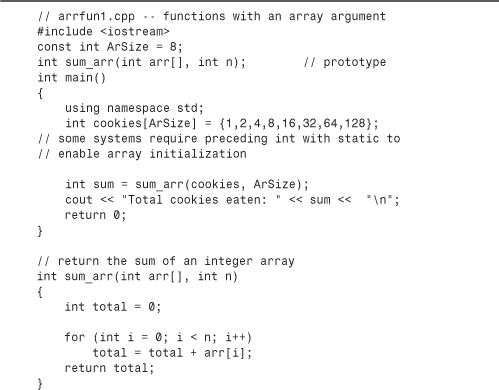
Here is the output of the program in Listing 7.5:
Total cookies eaten: 255
As you can see, the program works. Now let’s look at why it works.
How Pointers Enable Array-Processing Functions
The key to the program in Listing 7.5 is that C++, like C, in most contexts treats the name of an array as if it were a pointer. Recall from Chapter 4, “Compound Types,” that C++ interprets an array name as the address of its first element:
cookies == &cookies[0] // array name is address of first element
(There are two exceptions to this rule. First, the array declaration uses the array name to label the storage. Second, applying sizeof to an array name yields the size of the whole array, in bytes.)
Listing 7.5 makes the following function call:
int sum = sum_arr(cookies, ArSize);
Here cookies is the name of an array, hence by C++ rules cookies is the address of the array’s first element. The function passes an address. Because the array has type int elements, cookies must be type pointer-to-int, or int *. This suggests that the correct function header should be this:
int sum_arr(int * arr, int n) // arr = array name, n = size
Here int *arr has replaced int arr[]. It turns out that both headers are correct because in C++ the notations int *arr and int arr[] have the identical meaning when (and only when) used in a function header or function prototype. Both mean that arr is a pointer-to-int. However, the array notation version (int arr[]) symbolically reminds you that arr not only points to an int, it points to the first int in an array of ints. This book uses the array notation when the pointer is to the first element of an array, and it uses the pointer notation when the pointer is to an isolated value. Remember that the notations int *arr and int arr[] are not synonymous in any other context. For example, you can’t use the notation int tip[] to declare a pointer in the body of a function.
Given that the variable arr actually is a pointer, the rest of the function makes sense. As you might recall from the discussion of dynamic arrays in Chapter 4, you can use the bracket array notation equally well with array names or with pointers to access elements of an array. Whether arr is a pointer or an array name, the expression arr[3] means the fourth element of the array. And it probably will do no harm at this point to remind you of the following two identities:
arr[i] == *(ar + i) // values in two notations
&arr[i] == ar + i // addresses in two notations
Remember that adding one to a pointer, including an array name, actually adds a value equal to the size, in bytes, of the type to which the pointer points. Pointer addition and array subscription are two equivalent ways of counting elements from the beginning of an array.
The Implications of Using Arrays as Arguments
Let’s look at the implications of Listing 7.5. The function call sum_arr(cookies, ArSize) passes the address of the first element of the cookies array and the number of elements of the array to the sum_arr() function. The sum_arr() function assigns the cookies address to the pointer variable arr and assigns ArSize to the int variable n. This means Listing 7.5 doesn’t really pass the array contents to the function. Instead, it tells the function where the array is (the address), what kind of elements it has (the type), and how many elements it has (the n variable). (See Figure 7.4.) Armed with this information, the function then uses the original array. If you pass an ordinary variable, the function works with a copy. But if you pass an array, the function works with the original. Actually, this difference doesn’t violate C++’s pass-by-value approach. The sum_arr() function still passes a value that’s assigned to a new variable. But that value is a single address, not the contents of an array.
Figure 7.4. Telling a function about an array.
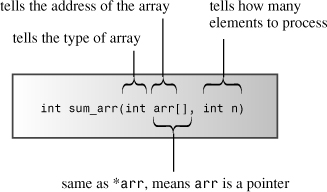
Is the correspondence between array names and pointers a good thing? Indeed, it is. The design decision to use array addresses as arguments saves the time and memory needed to copy an entire array. The overhead for using copies can be prohibitive if you’re working with large arrays. With copies, not only does a program need more computer memory, but it has to spend time copying large blocks of data. On the other hand, working with the original data raises the possibility of inadvertent data corruption. That’s a real problem in classic C, but ANSI C and C++’s const modifier provides a remedy. You’ll soon see an example. But first, let’s alter Listing 7.5 to illustrate some points about how array functions operate. Listing 7.6 demonstrates that cookies and arr have the same value. It also shows how the pointer concept makes the sum_arr function more versatile than it may have appeared at first. To provide a bit of variety and to show you what it looks like, the program uses the std:: qualifier instead of the using directive to provide access to cout and endl.
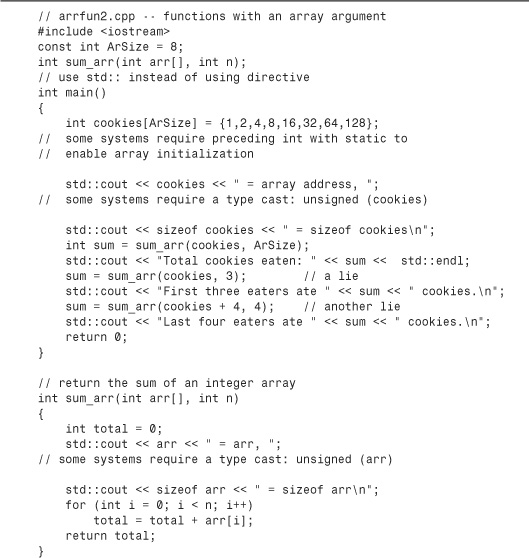
Here’s the output of the program in Listing 7.6:
0x0065fd24 = array address, 32 = sizeof cookies
0x0065fd24 = arr, 4 = sizeof arr
Total cookies eaten: 255
0x0065fd24 = arr, 4 = sizeof arr
First three eaters ate 7 cookies.
0x0065fd34 = arr, 4 = sizeof arr
Last four eaters ate 240 cookies.
Note that the address values and the array and integer sizes will vary from system to system. Also, some implementations will display the addresses in base 10 notation instead of in hexadecimal.
Program Notes
Listing 7.6 illustrates some very interesting points about array functions. First, note that cookies and arr both evaluate to the same address, exactly as claimed. But sizeof cookies is 16, whereas sizeof arr is only 4. That’s because sizeof cookies is the size of the whole array, whereas sizeof arr is the size of the pointer variable. (This program execution takes place on a system that uses 4-byte addresses.) By the way, this is why you have to explicitly pass the size of the array rather than use sizeof arr in sum_arr().
Because the only way sum_arr() knows the number of elements in the array is through what you tell it with the second argument, you can lie to the function. For example, the second time the program uses the function, it makes this call:
sum = sum_arr(cookies, 3);
By telling the function that cookies has just three elements, you get the function to calculate the sum of the first three elements.
Why stop there? You can also lie about where the array starts:
sum = sum_arr(cookies + 4, 4);
Because cookies acts as the address of the first element, cookies + 4 acts as the address of the fifth element. This statement sums the fifth, sixth, seventh, and eighth elements of the array. Note in the output how the third call to the function assigns a different address to arr than the first two calls did. And yes, you can use &cookies[4] instead of cookies + 4 as the argument; they both mean the same thing.
Remember
![]()
To indicate the kind of array and the number of elements to an array-processing function, you pass the information as two separate arguments:
void fillArray(int arr[], int size); // prototype
Don’t try to pass the array size by using brackets notation:
void fillArray(int arr[size]); // NO -- bad prototype
More Array Function Examples
When you choose to use an array to represent data, you are making a design decision. But design decisions should go beyond how data is stored; they should also involve how the data is used. Often, you’ll find it profitable to write specific functions to handle specific data operations. (The profits here include increased program reliability, ease of modification, and ease of debugging.) Also, when you begin integrating storage properties with operations when you think about a program, you are taking an important step toward the OOP mind-set; that, too, might prove profitable in the future.
Let’s examine a simple case. Suppose you want to use an array to keep track of the dollar values of your real estate. (If necessary, suppose you have real estate.) You have to decide what type to use. Certainly, double is less restrictive in its range than int or long, and it provides enough significant digits to represent the values precisely. Next, you have to decide on the number of array elements. (With dynamic arrays created with new, you can put off that decision, but let’s keep things simple.) Let’s say that you have no more than five properties, so you can use an array of five doubles.
Now consider the possible operations you might want to execute with the real estate array. Two very basic ones are reading values into the array and displaying the array contents. Let’s add one more operation to the list: reassessing the value of the properties. For simplicity, assume that all your properties increase or decrease in value at the same rate. (Remember, this is a book on C++, not on real estate management.) Next, fit a function to each operation and then write the code accordingly. We’ll go through the steps of creating these pieces of a program next. Afterward, we’ll fit them into a complete example.
Filling the Array
Because a function with an array name argument accesses the original array, not a copy, you can use a function call to assign values to array elements. One argument to the function will be the name of the array to be filled. In general, a program might manage more than one person’s investments, hence more than one array, so you don’t want to build the array size into the function. Instead, you pass the array size as a second argument, as in the previous example. Also, it’s possible that you might want to quit reading data before filling the array, so you want to build that feature in to the function. Because you might enter fewer than the maximum number of elements, it makes sense to have the function return the actual number of values entered. These considerations suggest the following function prototype:
int fill_array(double ar[], int limit);
The function takes an array name argument and an argument specifying the maximum number of items to be read, and the function returns the actual number of items read. For example, if you use this function with an array of five elements, you pass 5 as the second argument. If you then enter only three values, the function returns 3.
You can use a loop to read successive values into the array, but how can you terminate the loop early? One way is to use a special value to indicate the end of input. Because no property should have a negative value, you can use a negative number to indicate the end of input. Also, the function should do something about bad input, such as terminating further input. Given this, you can code the function as follows:
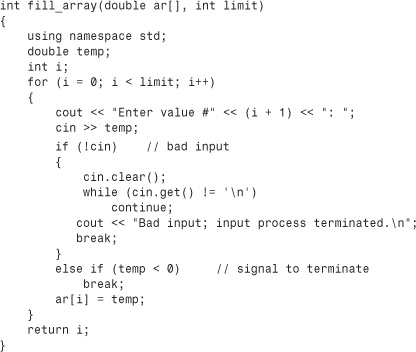
Note that this code includes a prompt to the user. If the user enters a non-negative value, the value is assigned to the array. Otherwise, the loop terminates. If the user enters only valid values, the loop terminates after it reads limit values. The last thing the loop does is increment i, so after the loop terminates, i is one greater than the last array index, hence it’s equal to the number of filled elements. The function then returns that value.
Showing the Array and Protecting It with const
Building a function to display the array contents is simple. You pass the name of the array and the number of filled elements to the function, which then uses a loop to display each element. But there is another consideration—guaranteeing that the display function doesn’t alter the original array. Unless the purpose of a function is to alter data passed to it, you should safeguard it from doing so. That protection comes automatically with ordinary arguments because C++ passes them by value, and the function works with a copy. But functions that use an array work with the original. After all, that’s why the fill_array() function is able to do its job. To keep a function from accidentally altering the contents of an array argument, you can use the keyword const (discussed in Chapter 3, “Dealing with Data”) when you declare the formal argument:
void show_array(const double ar[], int n);
The declaration states that the pointer ar points to constant data. This means that you can’t use ar to change the data. That is, you can use a value such as ar[0], but you can’t change that value. Note that this doesn’t mean that the original array needs be constant; it just means that you can’t use ar in the show_array() function to change the data. Thus, show_array() treats the array as read-only data. Suppose you accidentally violate this restriction by doing something like the following in the show_array() function:
ar[0] += 10;
In this case, the compiler will put a stop to your wrongful ways. Borland C++, for example, gives an error message like this (edited slightly):
Cannot modify a const object in function
show_array(const double *,int)
Other compilers may choose to express their displeasure in different words.
The message reminds you that C++ interprets the declaration const double ar[] to mean const double *ar. Thus, the declaration really says that ar points to a constant value. We’ll discuss this in detail when we finish with the current example. Meanwhile, here is the code for the show_array() function:
void show_array(const double ar[], int n)
{
using namespace std;
for (int i = 0; i < n; i++)
{
cout << "Property #" << (i + 1) << ": $";
cout << ar[i] << endl;
}
}
Modifying the Array
The third operation for the array in this example is multiplying each element by the same revaluation factor. You need to pass three arguments to the function: the factor, the array, and the number of elements. No return value is needed, so the function can look like this:
void revalue(double r, double ar[], int n)
{
for (int i = 0; i < n; i++)
ar[i] *= r;
}
Because this function is supposed to alter the array values, you don’t use const when you declare ar.
Putting the Pieces Together
Now that you’ve defined a data type in terms of how it’s stored (an array) and how it’s used (three functions), you can put together a program that uses the design. Because you’ve already built all the array-handling tools, you’ve greatly simplified programming main(). Most of the remaining programming work consists of having main() call the functions you’ve just developed. Listing 7.7 shows the result. It places a using directive in just those functions that use the iostream facilities.
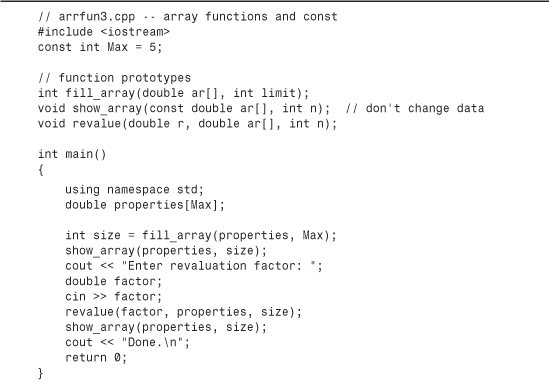

Here are two sample runs of the program in Listing 7.7:
Enter value #1: 100000
Enter value #2: 80000
Enter value #3: 222000
Enter value #4: 240000
Enter value #5: 118000
Property #1: $100000
Property #2: $80000
Property #3: $222000
Property #4: $240000
Property #5: $118000
Enter reassessment rate: 1.10
Property #1: $110000
Property #2: $88000
Property #3: $244200
Property #4: $264000
Property #5: $129800
Done.
Enter value #1: 200000
Enter value #2: 84000
Enter value #3: 160000
Enter value #4: -2
Property #1: $200000
Property #2: $84000
Property #3: $160000
Enter reassessment rate: 1.20
Property #1: $240000
Property #2: $100800
Property #3: $192000
Done.
Recall that fill_array() prescribes that input should quit when the user enters five properties or enters a negative number, whichever comes first. The first output example illustrates reaching the five-property limit, and the second output example illustrates that entering a negative value terminates the input phase.
Program Notes
We’ve already discussed the important programming details related to the real estate example, so let’s reflect on the process. You began by thinking about the data type and designed appropriate functions to handle the data. Then, you assembled these functions into a program. This is sometimes called bottom-up programming because the design process moves from the component parts to the whole. This approach is well suited to OOP, which concentrates on data representation and manipulation first. Traditional procedural programming, on the other hand, leans toward top-down programming, in which you develop a modular grand design first and then turn your attention to the details. Both methods are useful, and both lead to modular programs.
Functions Using Array Ranges
As you’ve seen, C++ functions that process arrays need to be informed about the kind of data in the array, the location of the beginning of the array, and the number of elements in the array. The traditional C/C++ approach to functions that process arrays is to pass a pointer to the start of the array as one argument and to pass the size of the array as a second argument. (The pointer tells the function both where to find the array and the kind of data in it.) That gives the function the information it needs to find all the data.
There is another approach to giving a function the information it needs: to specify a range of elements. This can be done by passing two pointers—one identifying the start of the array and one identifying the end of the array. The C++ Standard Template Library (STL; presented in Chapter 16, “The string Class and the Standard Template Library”), for example, generalizes the range approach. The STL approach uses the concept of “one past the end” to indicate an extent. That is, in the case of an array, the argument identifying the end of the array would be a pointer to the location just after the last element. For example, suppose you have this declaration:
double elbuod[20];
Then the two pointers elboud and elboud + 20 define the range. First, elboub, being the name of the array, points to the first element. The expression elboud + 19 points to the last element (that is, elboud[19]), so elboud + 20 points to one past the end of the array. Passing a range to a function tells it which elements to process. Listing 7.8 modifies Listing 7.6 to use two pointers to specify a range.
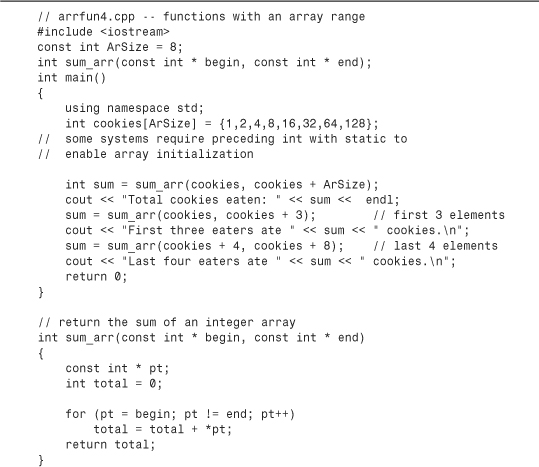
Here’s the output of the program in Listing 7.8:
Total cookies eaten: 255
First three eaters ate 7 cookies.
Last four eaters ate 240 cookies.
Program Notes
In Listing 7.8, notice the for loop in the sum_array() function:
for (pt = begin; pt != end; pt++)
total = total + *pt;
It sets pt to point to the first element to be processed (the one pointed to by begin) and adds *pt (the value of the element) to total. Then the loop updates pt by incrementing it, causing it to point to the next element. The process continues as long as pt != end. When pt finally equals end, it’s pointing to the location following the last element of the range, so the loop halts.
Second, notice how the different function calls specify different ranges within the array:
int sum = sum_arr(cookies, cookies + ArSize);
...
sum = sum_arr(cookies, cookies + 3); // first 3 elements
...
sum = sum_arr(cookies + 4, cookies + 8); // last 4 elements
The pointer value cookies + ArSize points to the location following the last element. (The array has ArSize elements, so cookies[ArSize - 1] is the last element, and its address is cookies + ArSize - 1.) So the range cookies, cookies + ArSize specifies the entire array. Similarly, cookies, cookies + 3 specifies the first three elements, and so on.
Note, by the way, that the rules for pointer subtraction imply that, in sum_arr(), the expression end - begin is an integer value equal to the number of elements in the range.
Pointers and const
Using const with pointers has some subtle aspects (pointers always seem to have subtle aspects), so let’s take a closer look. You can use the const keyword two different ways with pointers. The first way is to make a pointer point to a constant object, and that prevents you from using the pointer to change the pointed-to value. The second way is to make the pointer itself constant, and that prevents you from changing where the pointer points. Now for the details.
First, let’s declare a pointer pt that points to a constant:
int age = 39;
const int * pt = &age;
This declaration states that pt points to a const int (39, in this case). Therefore, you can’t use pt to change that value. In other words, the value *pt is const and cannot be modified:
*pt += 1; // INVALID because pt points to a const int
cin >> *pt; // INVALID for the same reason
Now for a subtle point. This declaration for pt doesn’t necessarily mean that the value it points to is really a constant; it just means the value is a constant insofar as pt is concerned. For example, pt points to age, and age is not const. You can change the value of age directly by using the age variable, but you can’t change the value indirectly via the pt pointer:
*pt = 20; // INVALID because pt points to a const int
age = 20; // VALID because age is not declared to be const
In the past, you’ve assigned the address of a regular variable to a regular pointer. Now you’ve assigned the address of a regular variable to a pointer-to-const. That leaves two other possibilities: assigning the address of a const variable to a pointer-to-const and assigning the address of a const to a regular pointer. Are they both possible? The first is, and the second isn’t:
const float g_earth = 9.80;
const float * pe = &g_earth; // VALID
const float g_moon = 1.63;
float * pm = &g_moon; // INVALID
For the first case, you can use neither g_earth nor pe to change the value 9.80. C++ doesn’t allow the second case for a simple reason: If you can assign the address of g_moon to pm, then you can cheat and use pm to alter the value of g_moon. That makes a mockery of g_moon’s const status, so C++ prohibits you from assigning the address of a const to a non-const pointer. (If you are really desperate, you can use a type cast to override the restriction; see Chapter 15 for a discussion of the const_cast operator.)
The situation becomes a bit more complex if you have pointers to pointers. As you saw earlier, assigning a non-const pointer to a const pointer is okay, provided that you’re dealing with just one level of indirection:
int age = 39; // age++ is a valid operation
int * pd = &age; // *pd = 41 is a valid operation
const int * pt = pd; // *pt = 42 is an invalid operation
But pointer assignments that mix const and non-const in this manner are no longer safe when you go to two levels of indirection. If mixing const and non-const were allowed, you could do something like this:
const int **pp2;
int *p1;
const int n = 13;
pp2 = &p1; // not allowed, but suppose it were
*pp2 = &n; // valid, both const, but sets p1 to point at n
*p1 = 10; // valid, but changes const n
Here the code assigns a non-const address (&pl) to a const pointer (pp2), and that allows pl to be used to alter const data. So the rule that you can assign a non-const address or pointer to a const pointer works only if there is just one level of indirection—for example, if the pointer points to a fundamental data type.
Remember
![]()
You can assign the address of either const data or non-const data to a pointer-to-const, provided that the data type is not itself a pointer, but you can assign the address of non-const data only to a non-const pointer.
Suppose you have an array of const data:
const int months[12] = {31,28,31,30,31,30, 31, 31,30,31,30,31};
The prohibition against assigning the address of a constant array means that you cannot pass the array name as an argument to a function by using a non-constant formal argument:
int sum(int arr[], int n); // should have been const int arr[]
...
int j = sum(months, 12); // not allowed
This function call attempts to assign a const pointer (months) to a non-const pointer (arr), and the compiler disallows the function call.
For yet another subtle point, consider the following declarations:
int age = 39;
const int * pt = &age;
The const in the second declaration only prevents you from changing the value to which pt points, which is 39. It doesn’t prevent you from changing the value of pt itself. That is, you can assign a new address to pt:
int sage = 80;
pt = &sage; // okay to point to another location
But you still can’t use pt to change the value to which it points (now 80).
The second way to use const makes it impossible to change the value of the pointer itself:
int sloth = 3;
const int * ps = &sloth; // a pointer to const int
int * const finger = &sloth; // a const pointer to int
Note that the last declaration has repositioned the keyword const. This form of declaration constrains finger to point only to sloth. However, it allows you to use finger to alter the value of sloth. The middle declaration does not allow you to use ps to alter the value of sloth, but it permits you to have ps point to another location. In short, finger and *ps are both const, and *finger and ps are not const. (See Figure 7.5.)
Figure 7.5. Pointers-to-const and const pointers.
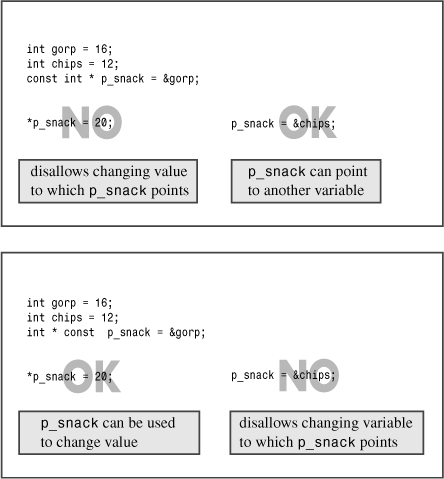
If you like, you can declare a const pointer to a const object:
double trouble = 2.0E30;
const double * const stick = &trouble;
Here stick can point only to trouble, and stick cannot be used to change the value of trouble. In short, both stick and *stick are const.
Typically you use the pointer-to-const form to protect data when you pass pointers as function arguments. For example, recall the show_array() prototype from Listing 7.5:
void show_array(const double ar[], int n);
Using const in this declaration means that show_array() cannot alter the values in any array that is passed to it. This technique works as long as there is just one level of indirection. Here, for example, the array elements are a fundamental type. But if they were pointers or pointers-to-pointers, you wouldn’t use const.
Functions and Two-Dimensional Arrays
To write a function that has a two-dimensional array as an argument, you need to remember that the name of an array is treated as its address, so the corresponding formal parameter is a pointer, just as for one-dimensional arrays. The tricky part is declaring the pointer correctly. Suppose, for example, that you start with this code:
int data[3][4] = {{1,2,3,4}, {9,8,7,6}, {2,4,6,8}};
int total = sum(data, 3);
What should the prototype for sum() look like? And why does the function pass the number of rows (3) as an argument and not also the number of columns (4)?
Well, data is the name of an array with three elements. The first element is, itself, an array of four int values. Thus, the type of data is pointer-to-array-of-four-int, so an appropriate prototype would be this:
int sum(int (*ar2)[4], int size);
The parentheses are needed because the declaration
int *ar2[4]
would declare an array of four pointers-to-int instead of a single pointer-to-array-of-four-int, and a function parameter cannot be an array. There’s an alternative format that means exactly the same thing as this first prototype, but, perhaps, is easier to read:
int sum(int ar2[][4], int size);
Either prototype states that ar2 is a pointer, not an array. Also note that the pointer type specifically says it points to an array of four ints. Thus, the pointer type specifies the number of columns, which is why the number of columns is not passed as a separate function argument.
Because the pointer type specifies the number of columns, the sum() function only works with arrays with four columns. But the number of rows is specified by the variable size, so sum() can work with a varying number of rows:
int a[100][4];
int b[6][4];
...
int total1 = sum(a, 100); // sum all of a
int total2 = sum(b, 6); // sum all of b
int total3 = sum(a, 10); // sum first 10 rows of a
int total4 = sum(a+10, 20); // sum next 20 rows of a
Given that the parameter ar2 is a pointer to an array, how do you use it in the function definition? The simplest way is to use ar2 as if it were the name of a two-dimensional array. Here’s a possible function definition:
int sum(int ar2[][4], int size)
{
int total = 0;
for (int r = 0; r < size; r++)
for (int c = 0; c < 4; c++)
total += ar2[r][c];
return total;
}
Again, note that the number of rows is whatever is passed to the size parameter, but the number of columns is fixed at four, both in the parameter declaration for ar2 and in the inner for loop.
Here’s why you can use array notation. Because ar2 points to the first element (element 0) of an array whose elements are array-of-four-int, the expression ar2 + r points to element number r. Therefore ar2[r] is element number r. That element is itself an array-of-four-int, so ar2[r] is the name of that array-of-four-int. Applying a subscript to an array name gives an array element, so ar2[r][c] is an element of the array-of-four-int, hence is a single int value. The pointer ar2 has to be dereferenced twice to get to the data. The simplest way is to use brackets twice, as in ar2[r][c]. But it is possible, if ungainly, to use the * operator twice:
ar2[r][c] == *(*(ar2 + r) + c) // same thing
To understand this, you can work out the meaning of the subexpressions from the inside out:
ar2 // pointer to first row of an array of 4 int
ar2 + r // pointer to row r (an array of 4 int)
*(ar2 + r) // row r (an array of 4 int, hence the name of an array,
// thus a pointer to the first int in the row, i.e., ar2[r]
*(ar2 +r) + c // pointer int number c in row r, i.e., ar2[r] + c
*(*(ar2 + r) + c // value of int number c in row r, i.e. ar2[r][c]
Incidentally, the code for sum() doesn’t use const in declaring the parameter ar2 because that technique is for pointers to fundamental types, and ar2 is a pointer to a pointer.
Functions and C-Style Strings
Recall that a C-style string consists of a series of characters terminated by the null character. Much of what you’ve learned about designing array functions applies to string functions, too. For example, passing a string as an argument means passing an address, and you can use const to protect a string argument from being altered. But there are a few special twists to strings that we’ll unravel now.
Functions with C-Style String Arguments
Suppose you want to pass a string as an argument to a function. You have three choices for representing a string:
• An array of char
• A quoted string constant (also called a string literal)
• A pointer-to-char set to the address of a string
All three choices, however, are type pointer-to-char (more concisely, type char *), so you can use all three as arguments to string-processing functions:
char ghost[15] = "galloping";
char * str = "galumphing";
int n1 = strlen(ghost); // ghost is &ghost[0]
int n2 = strlen(str); // pointer to char
int n3 = strlen("gamboling"); // address of string
Informally, you can say that you’re passing a string as an argument, but you’re really passing the address of the first character in the string. This implies that a string function prototype should use type char * as the type for the formal parameter representing a string.
One important difference between a C-style string and a regular array is that the string has a built-in terminating character. (Recall that a char array containing characters but no null character is just an array and not a string.) That means you don’t have to pass the size of the string as an argument. Instead, the function can use a loop to examine each character in the string in turn until the loop reaches the terminating null character. Listing 7.9 illustrates that approach with a function that counts the number of times a given character appears in a string.
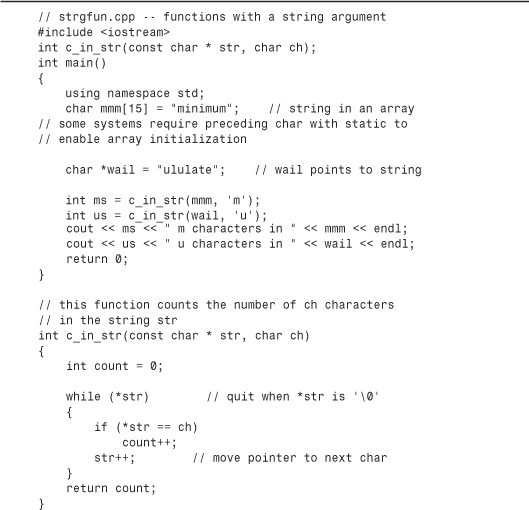
Here’s the output of the program in Listing 7.9:
3 m characters in minimum
2 u characters in ululate
Program Notes
Because the c_int_str() function in Listing 7.9 shouldn’t alter the original string, it uses the const modifier when it declares the formal parameter str. Then, if you mistakenly let the function alter part of the string, the compiler catches your error. Of course, you can use array notation instead to declare str in the function header:
int c_in_str(const char str[], char ch) // also okay
However, using pointer notation reminds you that the argument doesn’t have to be the name of an array but can be some other form of pointer.
The function itself demonstrates a standard way to process the characters in a string:
while (*str)
{
statements
str++;
}
Initially, str points to the first character in the string, so *str represents the first character itself. For example, immediately after the first function call, *str has the value m, the first character in minimum. As long as the character is not the null character (�), *str is nonzero, so the loop continues. At the end of each loop, the expression str++ increments the pointer by 1 byte so that it points to the next character in the string. Eventually, str points to the terminating null character, making *str equal to 0, which is the numeric code for the null character. That condition terminates the loop. (Why are string-processing functions ruthless? Because they stop at nothing.)
Functions That Return C-Style Strings
Now suppose you want to write a function that returns a string. Well, a function can’t do that. But it can return the address of a string, and that’s more efficient. Listing 7.10, for example, defines a function called buildstr() that returns a pointer. This function takes two arguments: a character and a number. Using new, the function creates a string whose length equals the number, and then it initializes each element to the character. Then, it returns a pointer to the new string.

Here’s a sample run of the program in Listing 7.10:

Program Notes
To create a string of n visible characters, you need storage for n + 1 characters in order to have space for the null character. So the function in Listing 7.10 asks for n + 1 bytes to hold the string. Next, it sets the final byte to the null character. Then, it fills in the rest of the array from back to front. In Listing 7.10, the loop
while (n-- > 0)
pstr[n] = c;
cycles n times as n decreases to 0, filling n elements. At the start of the final cycle, n has the value 1. Because n-- means use the value and then decrement it, the while loop test condition compares 1 to 0, finds the test to be true, and continues. But after making the test, the function decrements n to 0, so pstr[0] is the last element set to c. The reason for filling the string from back to front instead of front to back is to avoid using an additional variable. Using the other order would involve something like this:
int i = 0;
while (i < n)
pstr[i++] = c;
Note that the variable pstr is local to the buildstr function, so when that function terminates, the memory used for pstr (but not for the string) is freed. But because the function returns the value of pstr, the program is able to access the new string through the ps pointer in main().
The program in Listing 7.10 uses delete to free memory used for the string after the string is no longer needed. Then it reuses ps to point to the new block of memory obtained for the next string and frees that memory. The disadvantage to this kind of design (having a function return a pointer to memory allocated by new) is that it makes it the programmer’s responsibility to remember to use delete. In Chapter 12, “Classes and Dynamic Memory Allocation,” you’ll see how C++ classes, by using constructors and destructors, can take care of these details for you.
Functions and Structures
Let’s move from arrays to structures. It’s easier to write functions for structures than for arrays. Although structure variables resemble arrays in that both can hold several data items, structure variables behave like basic, single-valued variables when it comes to functions. That is, unlike an array, a structure ties its data in to a single entity that will be treated as a unit. Recall that you can assign one structure to another. Similarly, you can pass structures by value, just as you do with ordinary variables. In that case, the function works with a copy of the original structure. Also, a function can return a structure. There’s no funny business like the name of an array being the address of its first element. The name of a structure is simply the name of the structure, and if you want its address, you have to use the & address operator. (C++ and C both use the & symbol to denote the address operator. C++ additionally uses this operator to identify reference variables, to be discussed in Chapter 8.)
The most direct way to program by using structures is to treat them as you would treat the basic types—that is, pass them as arguments and use them, if necessary, as return values. However, there is one disadvantage to passing structures by value. If the structure is large, the space and effort involved in making a copy of a structure can increase memory requirements and slow down the system. For those reasons (and because, at first, C didn’t allow the passing of structures by value), many C programmers prefer passing the address of a structure and then using a pointer to access the structure contents. C++ provides a third alternative, called passing by reference, that is discussed in Chapter 8. Let’s examine the other two choices now, beginning with passing and returning entire structures.
Passing and Returning Structures
Passing structures by value makes the most sense when the structure is relatively compact, so let’s look at a couple examples along those lines. The first example deals with travel time (not to be confused with time travel). Some maps will tell you that it is 3 hours, 50 minutes, from Thunder Falls to Bingo City and 1 hour, 25 minutes, from Bingo City to Grotesquo. You can use a structure to represent such times, using one member for the hour value and a second member for the minute value. Adding two times is a little tricky because you might have to transfer some of the minutes to the hours part. For example, the two preceding times sum to 4 hours, 75 minutes, which should be converted to 5 hours, 15 minutes. Let’s develop a structure to represent a time value and then a function that takes two such structures as arguments and returns a structure that represents their sum.
Defining the structure is simple:
struct travel_time
{
int hours;
int mins;
};
Next, consider the prototype for a sum() function that returns the sum of two such structures. The return value should be type travel_time, and so should the two arguments. Thus, the prototype should look like this:
travel_time sum(travel_time t1, travel_time t2);
To add two times, you first add the minute members. Integer division by 60 yields the number of hours to carry over, and the modulus operation (%) yields the number of minutes left. Listing 7.11 incorporates this approach into the sum() function and adds a show_time() function to display the contents of a travel_time structure.
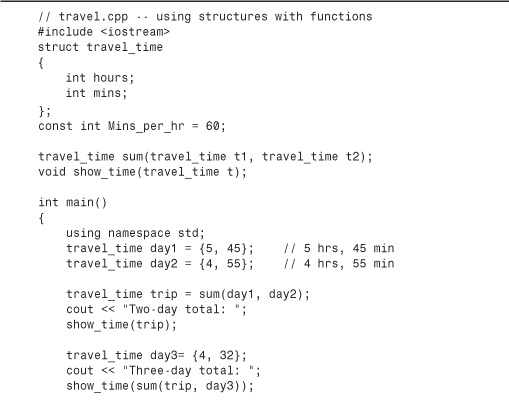
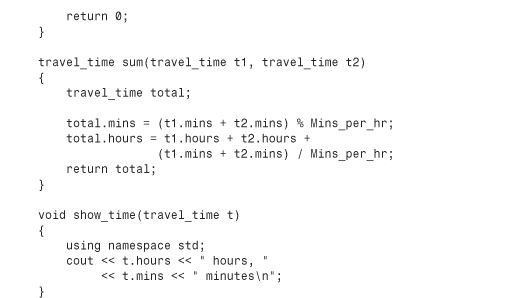
Here travel_time acts just like a standard type name; you can use it to declare variables, function return types, and function argument types. Because variables such as total and t1 are travel_time structures, you can apply the dot membership operator to them. Note that because the sum() function returns a travel_time structure, you can use it as an argument for the show_time() function. Because C++ functions, by default, pass arguments by value, the show_time(sum(trip, day3)) function call first evaluates the sum(trip, day3) function call in order to find its return value. The show_time() call then passes sum()’s return value, not the function itself, to show_time(). Here’s the output of the program in Listing 7.11:
Two-day total: 10 hours, 40 minutes
Three-day total: 15 hours, 12 minutes
Another Example of Using Functions with Structures
Much of what you learn about functions and C++ structures carries over to C++ classes, so it’s worth looking at a second example. This time let’s deal with space instead of time. In particular, this example defines two structures representing two different ways of describing positions and then develops functions to convert one form to the other and show the result. This example is a bit more mathematical than the last, but you don’t have to follow the mathematics to follow the C++.
Suppose you want to describe the position of a point on the screen or a location on a map relative to some origin. One way is to state the horizontal offset and the vertical offset of the point from the origin. Traditionally, mathematicians use the symbol x to represent the horizontal offset and y to represent the vertical offset. (See Figure 7.6.) Together, x and y constitute rectangular coordinates. You can define a structure consisting of two coordinates to represent a position:
struct rect
{
double x; // horizontal distance from origin
double y; // vertical distance from origin
};
Figure 7.6. Rectangular coordinates.
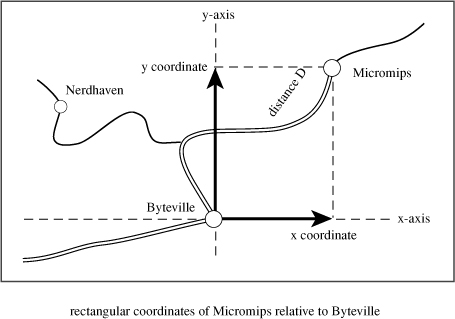
A second way to describe the position of a point is to state how far it is from the origin and in what direction it is (for example, 40 degrees north of east). Traditionally, mathematicians have measured the angle counterclockwise from the positive horizontal axis. (See Figure 7.7.) The distance and angle together constitute polar coordinates. You can define a second structure to represent this view of a position:
Figure 7.7. Polar coordinates.
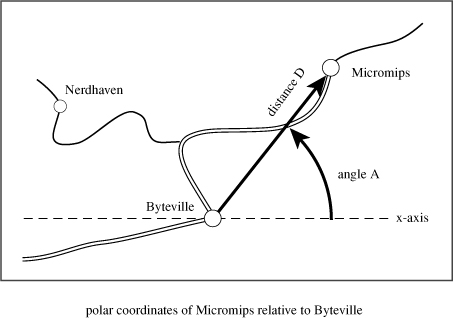
Let’s construct a function that displays the contents of a type polar structure. The math functions in the C++ library assume that angles are in radians, so you need to measure angles in that unit. But for display purposes, you can convert radian measure to degrees. This means multiplying by 180/π, which is approximately 57.29577951. Here’s the function:
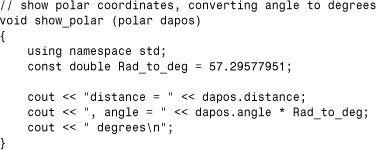
Notice that the formal variable is type polar. When you pass a polar structure to this function, the structure contents are copied into the dapos structure, and the function then uses that copy in its work. Because dapos is a structure, the function uses the membership (dot) operator (see Chapter 4) to identify structure members.
Next, let’s try something more ambitious and write a function that converts rectangular coordinates to polar coordinates. You should have the function accept a rect structure as its argument and return a polar structure to the calling function. This involves using functions from the math library, so the program has to include the math.h header file. Also, on some systems you have to tell the compiler to load the math library (see Chapter 1, “Getting Started”). You can use the Pythagorean theorem to get the distance from the horizontal and vertical components:
distance = sqrt( x * x + y * y)
The atan2() function from the math library calculates the angle from the x and y values:
angle = atan2(y, x)
(There’s also an atan() function, but it doesn’t distinguish between angles 180 degrees apart. That uncertainty is no more desirable in a math function than it is in a wilderness guide.)
Given these formulas, you can write the function as follows:
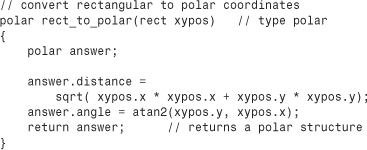
Now that the functions are ready, writing the rest of the program is straightforward. Listing 7.12 presents the result.
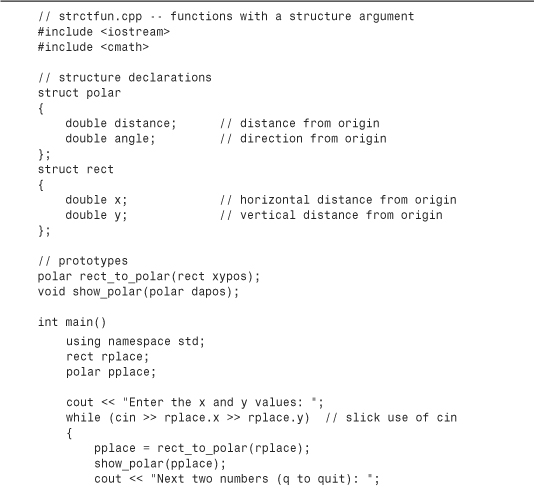
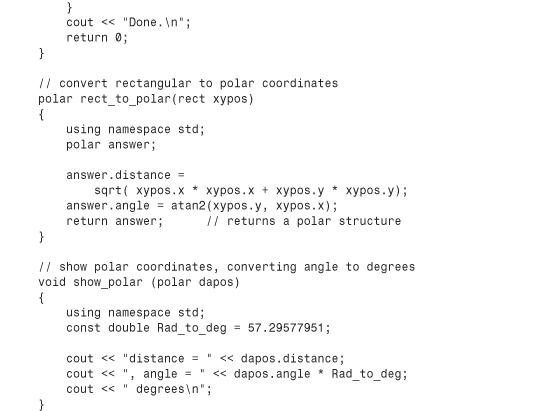
Compatibility Note
![]()
Some C++ implementations still use math.h instead of the newer cmath header file. Some compilers require explicit instructions to search the math library. For example, older versions of g++ uses this command line:
g++ structfun.C -lm
Here is a sample run of the program in Listing 7.12:
Enter the x and y values: 30 40
distance = 50, angle = 53.1301 degrees
Next two numbers (q to quit): -100 100
distance = 141.421, angle = 135 degrees
Next two numbers (q to quit): q
Program Notes
We’ve already discussed the two functions in Listing 7.12, so let’s review how the program uses cin to control a while loop:
while (cin >> rplace.x >> rplace.y)
Recall that cin is an object of the istream class. The extraction operator (>>) is designed in such a way that cin >> rplace.x also is an object of that type. As you’ll see in Chapter 11, “Working with Classes,” class operators are implemented with functions. What really happens when you use cin >> rplace.x is that the program calls a function that returns a type istream value. If you apply the extraction operator to the cin >> rplace.x object (as in cin >> rplace.x >> rplace.y), you again get an object of the istream class. Thus, the entire while loop test expression eventually evaluates to cin, which, as you may recall, when used in the context of a test expression, is converted to a bool value of true or false, depending on whether input succeeded. In the loop in Listing 7.12, for example, cin expects the user to enter two numbers. If, instead, the user enters q, as shown in the sample output, cin >> recognizes that q is not a number. It leaves the q in the input queue and returns a value that’s converted to false, terminating the loop.
Compare that approach for reading numbers to this simpler one:
for (int i = 0; i < limit; i++)
{
cout << "Enter value #" << (i + 1) << ": ";
cin >> temp;
if (temp < 0)
break;
ar[i] = temp;
}
To terminate this loop early, you enter a negative number. This restricts input to non-negative values. This restriction fits the needs of some programs, but more typically you would want a means of terminating a loop that doesn’t exclude certain numeric values. Using cin >> as the test condition eliminates such restrictions because it accepts all valid numeric input. You should keep this trick in mind when you need an input loop for numbers. Also, you should keep in mind that non-numeric input sets an error condition that prevents the reading of any more input. If a program needs input subsequent to the input loop, you must use cin.clear() to reset input, and you might then need to get rid of the offending input by reading it. Listing 7.7 illustrates those techniques.
Passing Structure Addresses
Suppose you want to save time and space by passing the address of a structure instead of passing the entire structure. This requires rewriting the functions so that they use pointers to structures. First, let’s look at how you rewrite the show_polar() function. You need to make three changes:
• When calling the function, pass it the address of the structure (&pplace) rather than the structure itself (pplace).
• Declare the formal parameter to be a pointer-to-polar—that is, type polar *. Because the function shouldn’t modify the structure, use the const modifier.
• Because the formal parameter is a pointer instead of a structure, use the indirect membership operator (->) rather than the membership operator (dot).
After these changes are made, the function looks like this:

Next, let’s alter rect_to_polar. This is more involved because the original rect_to_polar function returns a structure. To take full advantage of pointer efficiency, you should use a pointer instead of a return value. The way to do this is to pass two pointers to the function. The first points to the structure to be converted, and the second points to the structure that’s to hold the conversion. Instead of returning a new structure, the function modifies an existing structure in the calling function. Hence, although the first argument is const pointer, the second is not const. Otherwise, you apply the same principles used to convert show_polar() to pointer arguments. Listing 7.13 shows the reworked program.

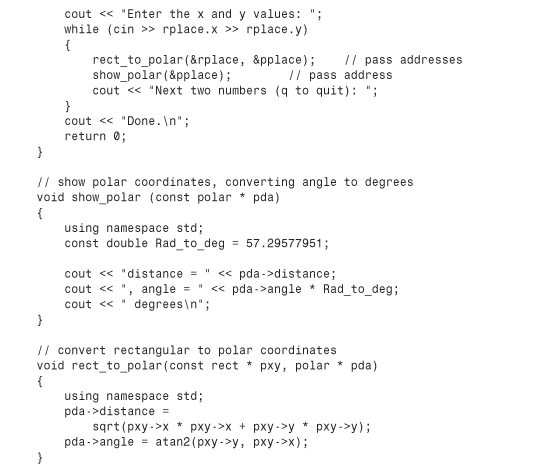
Compatibility Note
![]()
Some C++ implementations still use math.h instead of the newer cmath header file. Some compilers require explicit instructions to search the math library.
From the user’s standpoint, the program in Listing 7.13 behaves like that in Listing 7.12. The hidden difference is that Listing 7.12 works with copies of structures, whereas Listing 7.13 uses pointers to the original structures.
Functions and string Class Objects
Although C-style strings and string class objects serve much the same purpose, a string class object is more closely related to a structure than to an array. For example, you can assign a structure to another structure and an object to another object. You can pass a structure as a complete entity to a function, and you can pass an object as a complete entity. If you need several strings, you can declare a one-dimensional array of string objects instead of a two-dimensional array of char.
Listing 7.14 provides a short example that declares an array of string objects and passes the array to a function that displays the contents.
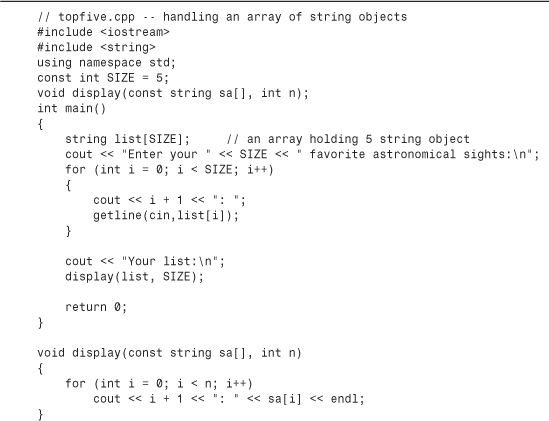
Compatibility Notes
![]()
Some older versions of Visual C++ have a bug that throws off the synchronization of the input and output statements. With one of these versions, you may have to type a response before the computer displays the prompt for that response.
Here’s a sample run of the program in Listing 7.14:
Enter your 5 favorite astronomical sights:
1: Orion Nebula
2: M13
3: Saturn
4: Jupiter
5: Moon
Your list:
1: Orion Nebula
2: M13
3: Saturn
4: Jupiter
5: Moon
The main point to note in this example is that, aside from the getline() function, this program treats string just as it would treat any of the built-in types, such as int. If you want an array of string, you just use the usual array-declaration format:
string list[SIZE]; // an array holding 5 string object
Each element of the list array, then, is a string object and can be used as such:
getline(cin,list[i]);
Similarly, the formal argument sa is a pointer to a string object, so sa[i] is a string object and can be used accordingly:
cout << i + 1 << ": " << sa[i] << endl;
Recursion
And now for something completely different. A C++ function has the interesting characteristic that it can call itself. (Unlike C, however, C++ does not let main() call itself.) This ability is termed recursion. Recursion is an important tool in certain types of programming, such as artificial intelligence, but we’ll just take a superficial look (artificial shallowness) at how it works.
Recursion with a Single Recursive Call
If a recursive function calls itself, then the newly called function calls itself, and so on, ad infinitum unless the code includes something to terminate the chain of calls. The usual method is to make the recursive call part of an if statement. For example, a type void recursive function called recurs() can have a form like this:
void recurs(argumentlist)
{
statements1
if (test)
recurs(arguments)
statements2
}
With luck or foresight, test eventually becomes false, and the chain of calls is broken.
Recursive calls produce an intriguing chain of events. As long as the if statement remains true, each call to recurs() executes statements1 and then invokes a new incarnation of recurs() without reaching statements2. When the if statement becomes false, the current call then proceeds to statements2. Then, when the current call terminates, program control returns to the previous version of recurs() that called it. Then, that version of recurs() completes executing its statements2 section and terminates, returning control to the prior call, and so on. Thus, if recurs() undergoes five recursive calls, first the statements1 section is executed five times in the order in which the functions were called, and then the statements2 section is executed five times in the opposite order from the order in which the functions were called. After going into five levels of recursion, the program then has to back out through the same five levels. Listing 7.15 illustrates this behavior.

Here’s the annotated output of the program in Listing 7.15:

Note that each recursive call creates its own set of variables, so by the time the program reaches the fifth call, it has five separate variables called n, each with a different value. You can verify this for yourself by modifying Listing 7.15 so that it displays the address of n as well as its value:
![]()
Doing so produces output like the following:
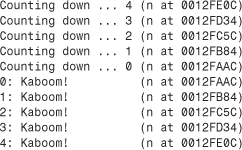
Note how the n having the value 4 is stored at one location (memory address 0012FE0C in this example), the n having the value 3 is stored at a second location (memory address 0012FD34), and so on.
Recursion with Multiple Recursive Calls
Recursion is particularly useful for situations that call for repeatedly subdividing a task into two smaller, similar tasks. For example, consider this approach to drawing a ruler. Mark the two ends, locate the midpoint, and mark it. Then, apply this same procedure to the left half of the ruler and then to the right half. If you want more subdivisions, apply the same procedure to each of the current subdivisions. This recursive approach is sometimes called the divide-and-conquer strategy. Listing 7.16 illustrates this approach, with the recursive function subdivide(). It uses a string initially filled with spaces except for a | character at each end. The main program uses a loop to call the subdivide() function six times, each time increasing the number of recursion levels and printing the resulting string. Thus, each line of output represents an additional level of recursion. To remind you that it’s an option, the program uses the std:: qualifier instead of a using directive.
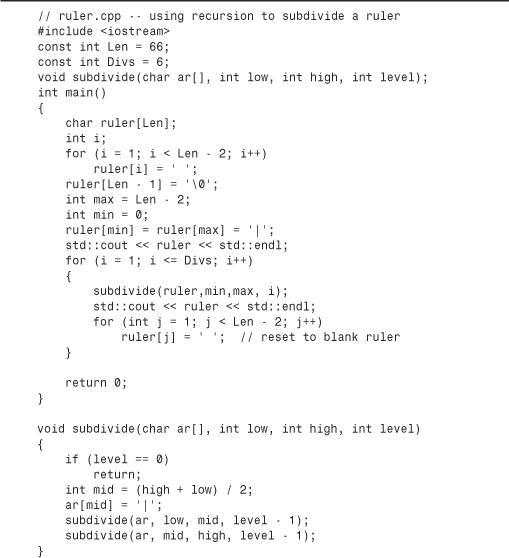
Here is the output of the program in Listing 7.16:

Program Notes
The subdivide() function in Listing 7.16 uses the variable level to control the recursion level. When the function calls itself, it reduces level by one, and the function with a level of 0 terminates. Note that subdivide() calls itself twice, once for the left subdivision and once for the right subdivision. The original midpoint becomes the right end for one call and the left end for the other call. Notice that the number of calls grows geometrically. That is, one call generates two, which generate four calls, which generate eight, and so on. That’s why the level 6 call is able to fill in 64 elements (26 = 64). This continued doubling of the number of function calls (and hence of the number of variables stored) make this form of recursion a poor choice if many levels of recursion are required. But it is an elegant and simple choice if the necessary levels of recursion are few.
Pointers to Functions
No discussion of C or C++ functions would be complete without mention of pointers to functions. We’ll take a quick look at this topic and leave the full exposition of the possibilities to more advanced texts.
Functions, like data items, have addresses. A function’s address is the memory address at which the stored machine language code for the function begins. Normally, it’s neither important nor useful for you or the user to know that address, but it can be useful to a program. For example, it’s possible to write a function that takes the address of another function as an argument. That enables the first function to find the second function and run it. This approach is more awkward than simply having the first function call the second one directly, but it leaves open the possibility of passing different function addresses at different times. That means the first function can use different functions at different times.
Function Pointer Basics
Let’s clarify this process with an example. Suppose you want to design an estimate() function that estimates the amount of time necessary to write a given number of lines of code, and you want different programmers to use the function. Part of the code for estimate() will be the same for all users, but the function will allow each programmer to provide his or her own algorithm for estimating time. The mechanism for that will be to pass to estimate() the address of the particular algorithm function the programmer wants to use. To implement this plan, you need to be able to do the following:
• Obtain the address of a function.
• Declare a pointer to a function.
• Use a pointer to a function to invoke the function.
Obtaining the Address of a Function
Obtaining the address of a function is simple: You just use the function name without trailing parentheses. That is, if think() is a function, then think is the address of the function. To pass a function as an argument, you pass the function name. Be sure you distinguish between passing the address of a function and passing the return value of a function:
process(think); // passes address of think() to process()
thought(think()); // passes return value of think() to thought()
The process() call enables the process() function to invoke the think() function from within process(). The thought() call first invokes the think() function and then passes the return value of think() to the thought() function.
Declaring a Pointer to a Function
To declare pointers to a data type, the declaration has had to specify exactly to what type the pointer points. Similarly, a pointer to a function has to specify to what type of function the pointer points. This means the declaration should identify the function’s return type and the function’s signature (its argument list). That is, the declaration should provide the same information about a function that a function prototype does. For example, suppose Pam LeCoder has written a time-estimating function with the following prototype:
double pam(int); // prototype
Here’s what a declaration of an appropriate pointer type looks like:
double (*pf)(int); // pf points to a function that takes
// one int argument and that
// returns type double
Note that this looks just like the pam() declaration, with (*pf) playing the part of pam. Because pam is a function, so is (*pf). And if (*pf) is a function, then pf is a pointer to a function.
Tip
![]()
In general, to declare a pointer to a particular kind of function, you can first write a prototype for a regular function of the desired kind and then replace the function name with an expression in the form (*pf). In this case, pf is a pointer to a function of that type.
The declaration requires the parentheses around *pf to provide the proper operator precedence. Parentheses have a higher precedence than the * operator, so *pf(int) means pf() is a function that returns a pointer, whereas (*pf)(int) means pf is a pointer to a function:
double (*pf)(int); // pf points to a function that returns double
double *pf(int); // pf() a function that returns a pointer-to-double
After you declare pf properly, you can assign to it the address of a matching function:
double pam(int);
double (*pf)(int);
pf = pam; // pf now points to the pam() function
Note that pam() has to match pf in both signature and return type. The compiler rejects nonmatching assignments:
double ned(double);
int ted(int);
double (*pf)(int);
pf = ned; // invalid -- mismatched signature
pf = ted; // invalid -- mismatched return types
Let’s return to the estimate() function mentioned earlier. Suppose you want to pass to it the number of lines of code to be written and the address of an estimating algorithm, such as the pam() function. It could have the following prototype:
void estimate(int lines, double (*pf)(int));
This declaration says the second argument is a pointer to a function that has an int argument and a double return value. To have estimate() use the pam() function, you pass pam()’s address to it:
estimate(50, pam); // function call telling estimate() to use pam()
Clearly, the tricky part about using pointers to functions is writing the prototypes, whereas passing the address is very simple.
Using a Pointer to Invoke a Function
Now we get to the final part of the technique, which is using a pointer to call the pointed-to function. The clue comes in the pointer declaration. There, recall, (*pf) plays the same role as a function name. Thus, all you have to do is use (*pf) as if it were a function name:

Actually, C++ also allows you to use pf as if it were a function name:
double y = pf(5); // also call pam() using the pointer pf
Using the first form is uglier, but it provides a strong visual reminder that the code is using a function pointer.
A Function Pointer Example
Listing 7.17 demonstrates using function pointers in a program. It calls the estimate() function twice, once passing the betsy() function address and once passing the pam() function address. In the first case, estimate() uses betsy() to calculate the number of hours necessary, and in the second case, estimate() uses pam() for the calculation. This design facilitates future program development. When Ralph develops his own algorithm for estimating time, he doesn’t have to rewrite estimate(). Instead, he merely needs to supply his own ralph() function, making sure it has the correct signature and return type. Of course, rewriting estimate() isn’t a difficult task, but the same principle applies to more complex code. Also, the function pointer method allows Ralph to modify the behavior of estimate(), even if he doesn’t have access to the source code for estimate().
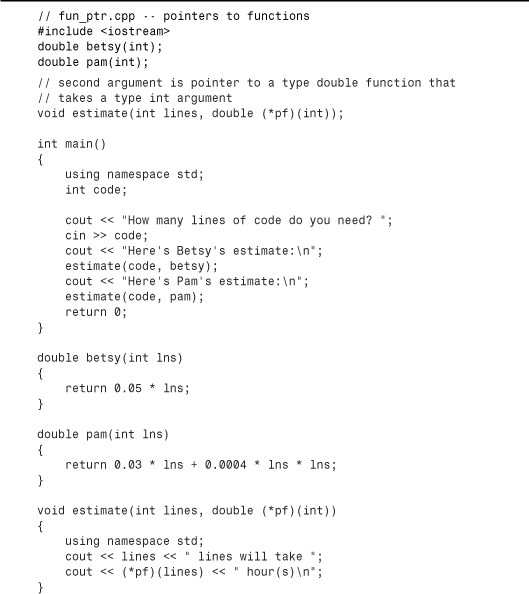
Here is a sample run of the program in Listing 7.17:
How many lines of code do you need? 30
Here's Betsy's estimate:
30 lines will take 1.5 hour(s)
Here's Pam's estimate:
30 lines will take 1.26 hour(s)
Here is a second sample run of the program:
How many lines of code do you need? 100
Here's Betsy's estimate:
100 lines will take 5 hour(s)
Here's Pam's estimate:
100 lines will take 7 hour(s)
Summary
Functions are the C++ programming modules. To use a function, you need to provide a definition and a prototype, and you have to use a function call. The function definition is the code that implements what the function does. The function prototype describes the function interface: how many and what kinds of values to pass to the function and what sort of return type, if any, to get from it. The function call causes the program to pass the function arguments to the function and to transfer program execution to the function code.
By default, C++ functions pass arguments by value. This means that the formal parameters in the function definition are new variables that are initialized to the values provided by the function call. Thus, C++ functions protect the integrity of the original data by working with copies.
C++ treats an array name argument as the address of the first element of the array. Technically, this is still passing by value because the pointer is a copy of the original address, but the function uses the pointer to access the contents of the original array. When you declare formal parameters for a function (and only then), the following two declarations are equivalent:
typeName arr[]
typeName * arr
Both of these mean that arr is a pointer to typeName. When you write the function code, however, you can use arr as if it were an array name in order to access elements: arr[i]. Even when passing pointers, you can preserve the integrity of the original data by declaring the formal argument to be a pointer to a const type. Because passing the address of an array conveys no information about the size of the array, you normally pass the array size as a separate argument.
C++ provides three ways to represent C-style strings: by using a character array, a string constant, or a pointer to a string. All are type char* (pointer-to-char), so they are passed to a function as a type char* argument. C++ uses the null character (�) to terminate strings, and string functions test for the null character to determine the end of any string they are processing.
C++ also provides the string class to represent strings. A function can accept string objects as arguments and use a string object as a return value. The string class size() method can be used to determine the length of a stored string.
C++ treats structures the same as basic types, meaning that you can pass them by value and use them as function return types. However, if a structure is large, it might be more efficient to pass a pointer to the structure and let the function work with the original data.
A C++ function can be recursive; that is, the code for a particular function can include a call of itself.
The name of a C++ function acts as the address of the function. By using a function argument that is a pointer to a function, you can pass to a function the name of a second function that you want the first function to evoke.
Review Questions
1. What are the three steps in using a function?
2. Construct function prototypes that match the following descriptions:
a. igor() takes no arguments and has no return value.
b. tofu() takes an int argument and returns a float.
c. mpg() takes two type double arguments and returns a double.
d. summation() takes the name of a long array and an array size as values and returns a long value.
e. doctor() takes a string argument (the string is not to be modified) and returns a double value.
f. ofcourse() takes a boss structure as an argument and returns nothing.
g. plot() takes a pointer to a map structure as an argument and returns a string.
3. Write a function that takes three arguments: the name of an int array, the array size, and an int value. Have the function set each element of the array to the int value.
4. Write a function that takes three arguments: a pointer to the first element of a range in an array, a pointer to the element following the end of a range in an array, and an int value. Have the function set each element of the array to the int value.
5. Write a function that takes a double array name and an array size as arguments and returns the largest value in that array. Note that this function shouldn’t alter the contents of the array.
6. Why don’t you use the const qualifier for function arguments that are one of the fundamental types?
7. What are the three forms a C-style string can take in a C++ program?
8. Write a function that has this prototype:
int replace(char * str, char c1, char c2);
Have the function replace every occurrence of c1 in the string str with c2, and have the function return the number of replacements it makes.
9. What does the expression *"pizza" mean? What about "taco"[2]?
10. C++ enables you to pass a structure by value, and it lets you pass the address of a structure. If glitz is a structure variable, how would you pass it by value? How would you pass its address? What are the trade-offs of the two approaches?
11. The function judge() has a type int return value. As an argument, it takes the address of a function. The function whose address is passed, in turn, takes a pointer to a const char as an argument and returns an int. Write the function prototype.
Programming Exercises
1. Write a program that repeatedly asks the user to enter pairs of numbers until at least one of the pair is 0. For each pair, the program should use a function to calculate the harmonic mean of the numbers. The function should return the answer to main(), which should report the result. The harmonic mean of the numbers is the inverse of the average of the inverses and can be calculated as follows:
harmonic mean = 2.0 × x × y / (x + y)
2. Write a program that asks the user to enter up to 10 golf scores, which are to be stored in an array. You should provide a means for the user to terminate input prior to entering 10 scores. The program should display all the scores on one line and report the average score. Handle input, display, and the average calculation with three separate array-processing functions.
3. Here is a structure declaration:
struct box
{
char maker[40];
float height;
float width;
float length;
float volume;
};
a. Write a function that passes a box structure by value and that displays the value of each member.
b. Write a function that passes the address of a box structure and that sets the volume member to the product of the other three dimensions.
c. Write a simple program that uses these two functions.
4. Many state lotteries use a variation of the simple lottery portrayed by Listing 7.4. In these variations you choose several numbers from one set and call them the field numbers. For example, you might select 5 numbers from the field of 1–47). You also pick a single number (called a mega number or a power ball, etc.) from a second range, such as 1–27. To win the grand prize, you have to guess all the picks correctly. The chance of winning is the product of the probability of picking all the field numbers times the probability of picking the mega number. For instance, the probability of winning the example described here is the product of the probability of picking 5 out of 47 correctly times the probability of picking 1 out of 27 correctly. Modify Listing 7.4 to calculate the probability of winning this kind of lottery.
5. Define a recursive function that takes an integer argument and returns the factorial of that argument. Recall that 3 factorial, written 3!, equals 3 × 2!, and so on, with 0! defined as 1. In general, if n is greater than zero, n! = n * (n − 1)!. Test your function in a program that uses a loop to allow the user to enter various values for which the program reports the factorial.
6. Write a program that uses the following functions:
Fill_array() takes as arguments the name of an array of double values and an array size. It prompts the user to enter double values to be entered in the array. It ceases taking input when the array is full or when the user enters non-numeric input, and it returns the actual number of entries.
Show_array() takes as arguments the name of an array of double values and an array size and displays the contents of the array.
Reverse_array() takes as arguments the name of an array of double values and an array size and reverses the order of the values stored in the array.
The program should use these functions to fill an array, show the array, reverse the array, show the array, reverse all but the first and last elements of the array, and then show the array.
7. Redo Listing 7.7, modifying the three array-handling functions to each use two pointer parameters to represent a range. The fill_array() function, instead of returning the actual number of items read, should return a pointer to the location after the last location filled; the other functions can use this pointer as the second argument to identify the end of the data.
8. This exercise provides practice in writing functions dealing with arrays and structures. The following is a program skeleton. Complete it by providing the described functions:
#include <iostream>
using namespace std;
const int SLEN = 30;
struct student {
char fullname[SLEN];
char hobby[SLEN];
int ooplevel;
};
// getinfo() has two arguments: a pointer to the first element of
// an array of student structures and an int representing the
// number of elements of the array. The function solicits and
// stores data about students. It terminates input upon filling
// the array or upon encountering a blank line for the student
// name. The function returns the actual number of array elements
// filled.
int getinfo(student pa[], int n);
// display1() takes a student structure as an argument
// and displays its contents
void display1(student st);
// display2() takes the address of student structure as an
// argument and displays the structure's contents
void display2(const student * ps);
// display3() takes the address of the first element of an array
// of student structures and the number of array elements as
// arguments and displays the contents of the structures
void display3(const student pa[], int n);
int main()
{
cout << "Enter class size: ";
int class_size;
cin >> class_size;
while (cin.get() != '
')
continue;
student * ptr_stu = new student[class_size];
int entered = getinfo(ptr_stu, class_size);
for (int i = 0; i < entered; i++)
{
display1(ptr_stu[i]);
display2(&ptr_stu[i]);
}
display3(ptr_stu, entered);
delete [] ptr_stu;
cout << "Done
";
return 0;
}
9. Design a function calculate() that takes two type double values and a pointer to a function that takes two double arguments and returns a double. The calculate() function should also be type double, and it should return the value that the pointed-to function calculates, using the double arguments to calculate(). For example, suppose you have this definition for the add() function:
double add(double x, double y)
{
return x + y;
}
Then, the function call in
double q = calculate(2.5, 10.4, add);
would cause calculate() to pass the values 2.5 and 10.4 to the add() function and then return the add() return value (12.9).
Use these functions and at least one additional function in the add() mold in a program. The program should use a loop that allows the user to enter pairs of numbers. For each pair, use calculate() to invoke add() and at least one other function. If you are feeling adventurous, try creating an array of pointers to add()-style functions and use a loop to successively apply calculate() to a series of functions by using these pointers. Hint: Here’s how to declare such an array of three pointers:
double (*pf[3])(double, double);
You can initialize such an array by using the usual array initialization syntax and function names as addresses.


